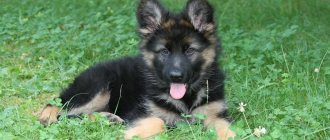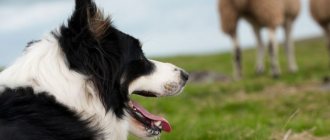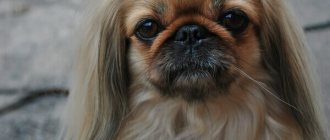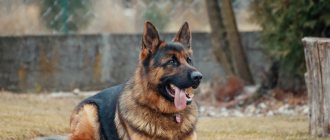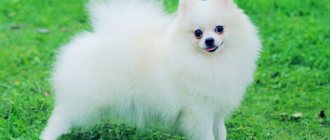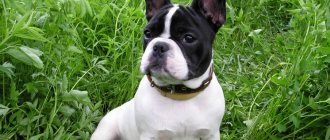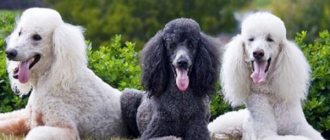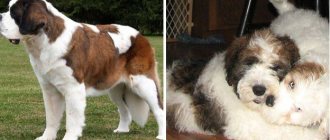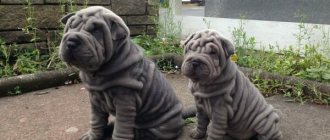90% of service dogs are representatives of the German Shepherd breed.
The founder of this breed, Max von Stefanitz, had the goal of breeding socially useful dogs with outstanding characteristics and good obedience.
They must be brave, tolerant of other animals, protect entrusted people and the herd, and carry out assigned tasks.
The result is excellent - the dogs are hardy, trainable, smart, and good friends. They are excellent guards and detectives.
In this article we will look at the types of German Shepherds - here you will find their descriptions with names and photographs.
Main varieties
There are two main varieties of German Shepherds:
- exhibition;
- workers.
The first demonstrate breed standards in terms of appearance, taking part in various exhibitions and undergoing testing for training. They also have working qualities, thanks to their gentle nature they serve as guides and guards, and provide canis therapy.
The latter do not have high standards of appearance , but well-developed muscles, strong bones and a strong, fearless character make it possible to regularly perform grueling service.
Dogs of both species participate in exhibitions, show working abilities, but the quality of the intended purpose of the species is always a priority.
Expert opinion
Kozhevin Semyon Kirillovich
Expert dog handler.
When a German Shepherd is supposed to come to me, I wait with excitement: “Which dog will come to me?”
A lot of people started breeding dogs of this breed, and due to ignorance in this matter, a whole population of spoiled dogs appeared.
According to my observations, there are three types of this breed:
- exterior;
- workers;
- from breeders (incompetent breeders hungry for quick money).
The first ones participate and win in exhibitions and rings, and pass training tests. They have a balanced nervous system, many are well guarded. The weak point is the joints; dogs often fall on their hind legs. Almost all representatives have some kind of disease, often related to the digestive system, and many have allergies.
The latter are not very similar to their elegant exterior counterparts. Structural features - no extra-long paws, more compact, less angular, similar to the old-type Germans. Confident in yourself. They are characterized by endurance - the main characteristic of the German Shepherd. It is the workers who preserve the character of the breed.
Still others look like German Shepherds. They are unfit for work, nervous, excitable and cowardly. The legs are very long, the narrowed muzzle is elongated, the chest is small in volume, and the bones are poor. The behavior of the future dog will be revealed by the habits of the parents, who should be observed so as not to fail when choosing a puppy.
Character of dogs of the German Shepherd breed
The German Shepherd has a fairly balanced character, special intelligence, friendliness, loyalty and calmness. But this is also influenced by proper education, which is very important to give to your pet.
If a shepherd puppy is not given time and taught various rules, then when he grows up, he will become unmanageable.
Such dogs need constant communication and physical exercise, they quickly learn new commands and master games, enjoy going for walks and love to play in nature.
The German Shepherd is incredibly loyal; such dogs are always ready to protect their owners at the cost of their own lives. She also gets along well with children, as she herself is quite affectionate. He loves to show his love and trust to his owners by rolling over on his back and allowing his belly to be stroked.
Despite the fact that the German Shepherd is an almost ideal pet, one should not lose sight of the fact that it will not always be friendly to strangers, since it does not know whether a stranger can harm its owner. Therefore, the owner must immediately show that the stranger has no evil intentions, after which the dog will change its attitude towards him.
Classification by coat length
Based on the length of their coat, German Shepherds are classified as smooth-haired ( short-haired ) or long-haired .
Smooth-haired cats have a double body covering - hair with a thick undercoat. The first should fit snugly to the body, be straight and rigid. The hair is longer on the neck, back of the paws and tail, shorter and thicker at the base of the ears, front of the paws, and toes. On the back of the thigh are pants.
In any litter there will be a puppy that differs from its brothers in the length of its fur. Long-haired individuals have longer hair, the undercoat is slightly marked. At the base of the ears, the hair is collected in bristling tufts, and on the tail it is 2-4 times longer than that of shorthairs.
Nutrition
A German Shepherd puppy needs a complete, balanced diet. If fed incorrectly, he will grow up weak, sad and distant, and his coat will not have shine. It is important that the baby receives amino acids and proteins every day. These nutrients are found in milk, cereals and meat.
A complete list of foods that should be fed daily to a puppy from 2 to 8 months:
- Buckwheat or wheat porridge.
- Chicken (preferably raw).
- Milk or semolina.
- Cucumbers, broccoli, lettuce, tomatoes.
- Bananas, strawberries, apples, melon.
Never feed your pet raw sea fish, as it contains bones and possibly parasites. It is also recommended to permanently eliminate pork, smoked lard, sharp bones (especially beef), chocolate, biscuits and marmalade from his menu. Eating such foods can cause digestive dysfunction in dogs. Dry food can be given to an adult “German” over 1 year old.
Photos and descriptions of species
Based on their uniqueness, character traits , and distinctive external features, breeding lines of the breed are divided into three types:
- German exhibition;
- European workers (subspecies - Western, Czech, East German, Dutch, Belgian);
- American exhibition.
Old type
The German Shepherd of the old type of breeding differed from its contemporaries in its tall, dry, sinewy body with strong bones, which corresponded to the standards of the forties and fifties of the twentieth century.
The old-type American line (bred before the seventies of the twentieth century), which did not show outstanding results, has almost disappeared. The reason for this is the development of a new American breeding line.
Workers
The East German line was created from the remaining dogs in East Germany after World War II. Dogs of this line have a variety of working qualities and good build, having heavy bones and a large head. Some are aggressive. Hardy, capable of learning.
Partners for breeding working lines are selected based on high estimates of suitability for the breed. The goal of breeding is to create a dog that exceeds all previous characteristics of the breed. For this purpose, it is not so much the beautiful who are selected as the brave, quick-witted, willing and able to carry out assigned tasks, with a balanced psyche and flexible character.
Dogs must not only work, but also produce good offspring. Priority is given to health - if the animal is of good character, but with diseases, it will not be able to serve. Therefore, working line dogs are powerful, fast and agile, and very hardy.
The appearance is not much different from the exterior of the ancestors. Working shepherds come in different sizes - either squat, short-bodied and dense, or tall and thin, with short or long hair. Any color, black saddle is more common.
Used as utility vehicles, they are successful in police and search and rescue work. Ideal for work in the ring, sports, competitive level (for example, agility) competitions, personal protection.
American
In the category of American exhibition lines I also include Canadian ones. The goal is to breed dogs for the show ring, where conformation, movement, and appearance are assessed.
This species is now fundamentally different from the original German Shepherds imported to North America and from the European Shepherds. This happened due to differences in standard requirements in Europe and America.
NOTE!
The American Kennel Club has no requirements for both parents; registration as purebred shepherd dogs is sufficient. Even puppies that do not pass health, temperament and performance tests can participate in the production of offspring.
American Shepherds differ from German Shepherds in the height at the withers and the length of the body. They have thinner bones, the body and head are narrower. The color is traditional saddleback, there are black and white individuals.
English
The line was bred from old-type German Shepherds that were imported to the British Isles. They were used as police officers and guides due to their gentle nature.
Since England did not prohibit the import of German Shepherds after the war, they supplanted the English breeding line.
German (high breeding)
Representatives of this line are popular in Germany as they are closest to the standards. Distributed all over the world due to its exhibition exterior. Easy to get divorced. The color is predominantly black and red, the step is smooth.
Flaws:
- weak character;
- fading pigmentation.
IMPORTANT!
In Germany, parents of puppies registered as German Shepherds must have conformation assessments, training results and medical testing, which provides some guarantee of the health of the breeding stock.
Thanks to this, dogs of show lines retain working qualities that allow them to serve and participate in competitions. But the main focus of breeders is on improving appearance. Therefore, a dog that is not distinguished by good health and strong character, but with an excellent exterior, will be selected as a mating partner.
Czech
This line was developed during communist Czechoslovakia. The goals and culture of the then Eastern Europe determined the breeding of Czech Shepherds.
These dogs are suspicious and aggressive. Very similar to German working dogs in appearance, character and ability to serve. Significantly different from German and American show dogs.
Swiss
The German Shepherd of the Swiss breeding line has a white color .
White color (dominant hidden gene) is considered a defect in many countries and is disqualified.
NOTE!
The International Canine Organization (FCI), after attempts by breeders to achieve recognition of the white line, separated it into a separate breed - Swiss Shepherds. In North America they are recognized as Canadian or American White Shepherds.
These are dogs of good build, with a gentle character and variable temperament. They serve as guides.
White color helps in performance of duty and is in no way a sign of degeneration or albinism. Representatives of the Swiss line must have dark skin, irises, black pads and claws.
Kunming
In the fifties of the twentieth century, the Chinese province of Yannan with its capital Kuming needed military service. For this purpose, the Kunming line was bred on the model of the German shepherd (the likelihood of outbred producers is high). Ten Peking Wolfhounds, twenty local dogs and ten German Shepherds were crossed.
The result was medium-sized dogs with square body proportions and longer legs, resulting in a loss of elegant gait. The color is typical for Germans, variegated is allowed.
The psyche is stable, animals are capable of learning, and are excellent companions. They serve as military, police, and detectives.
Sarlouz Wulfhound
When crossing a European wolf with a German shepherd to improve the qualities of the breed, a genus was developed that was registered by the FCI system as Dutch.
An exhibition breed, the animals have a stable psyche and an aggressive character. Fearless, determined. The color is white or wolf. Wolfish habits progress and commands are difficult to carry out.
Girl
You can tell a girl from a boy by height and weight. Knots are usually smaller. The standard weight of a female is 22-32 kg, height - 55-60 cm.
Some dog lovers claim that there are no differences in temperament and behavior between males and females. But there are still some nuances.
Women are more sensitive than men. Their smaller size, greater agility and temperament mean they are easier to train.
The female dog is sweeter and more tolerant of strangers and children.
A girl comes into heat twice a year if she is not spayed. It usually lasts two or three weeks. During this time, her secretions will attract male dogs from many kilometers away. This can make walking difficult.
Popular colors
In accordance with the standards, the colors of German Shepherds are as follows:
- zonal (zonal-red, zonal-gray);
- black-and-white;
- plain gray;
- black plain;
- black and tan;
- black with a hint of brown, the so-called “dark sable”.
Due to its effectiveness, the most common color is sable. Breeders are working to restore the rest to their former glory.
IMPORTANT!
The basis for disqualification is weak pigmentation, indicating the inferiority of the individual, the presence of a disease - vulnerability of the skin to ultraviolet radiation. The reason for this is intraspecific crossing. The weakness of the pigment is manifested in the light color of the iris, white chest and paws, in light claws and the tip of the tail.
Grey
Greek and Central Asian, South Russian Shepherd Dogs, Briard - these are the breeds that can have a gray color.
An interesting breed is the Puli, which comes in white, gray, and other colors.
Puli dog
The fur is formed into cords that completely hide her brown eyes. Puli is a very smart and loyal, but also a serious dog.
If she thinks her owner is in danger, she will attack without warning.
The Catalan Shepherd is found in both gray and other colors.
Catalan Shepherd
Her coat is hard, with a thick undercoat, the dog is decorated with a lush collar, mustache, beard, and bangs. The wool is long.
The dog's appearance is very funny, and his character is energetic and cheerful.
The Romanian Mioritic Shepherd is massive, covered with thick white or fine hair, sometimes with different spots. She is surprisingly obedient and extremely affectionate.
Romanian Mioritic Shepherd Dog
Only the owner himself can train her: she “falls in love” with only one person, once and for all. The Romanian Shepherd will never betray its owner, even if he is no longer there.
Rules of care
Caring for zoned Germans is usually not difficult for owners. These are quite unpretentious animals in terms of keeping conditions. During the shedding period, the shepherd dog must be brushed every day; in normal times, it is enough to carry out this procedure 3-4 times a week. For combing, you can use a furminator or a special mitten.
The pet's eyes, ears and mouth must be inspected every day for dirt and possible inflammation. Cleaning is done as needed. The procedure for trimming nails for this breed is usually irrelevant; walks are enough, during which they grind down on hard surfaces on their own. However, if necessary, you can use a regular nail clipper.
Features of color
Shepherd dogs of this species are distinguished by their unusual coat color. The black and tan color is dominant in relation to the black color gene, but it prevails over the black and tan shade. Sometimes in nature there are individuals whose saddle cloth is weakened; this is due to the loss of the intensity of the black color on the back. If, when breeding dogs, the descendants of black-backed parents are used without admixture of other genes, then the color becomes lighter over time.
The main feature in the color of these shepherd dogs is that the saddle cloth (“black mantle”) can smoothly descend to the paws of the animal. As for the lower part of the body, it can be:
- red;
- gray;
- yellow;
- light brown.
Theses
- This is an active, intelligent dog. To keep her happy and calm, the owner must exercise her both physically and mentally. Games, learning or work - that's what she needs.
- Regular exercise is required, otherwise the dog will get bored and this will result in negative behavior.
- They are suspicious and distant towards strangers. In order for a dog to grow up calm and confident, it is necessary to carry out early socialization of the puppy. New places, smells, people, sounds, animals will help him in the future.
- These dogs are great for service, but are not recommended for those who are getting a dog for the first time.
- They shed throughout the year, so you need to comb out the dead hair regularly.
- It is advisable to take a training course, this will help you get a controllable dog.
- They perfectly protect their territory and family, but do not forget that without proper socialization and training they can attack random people.
